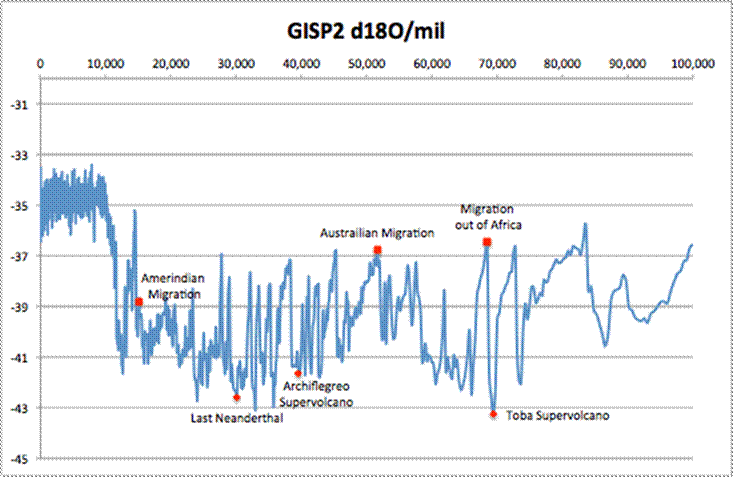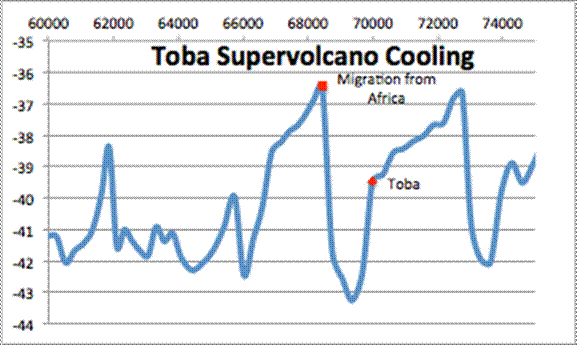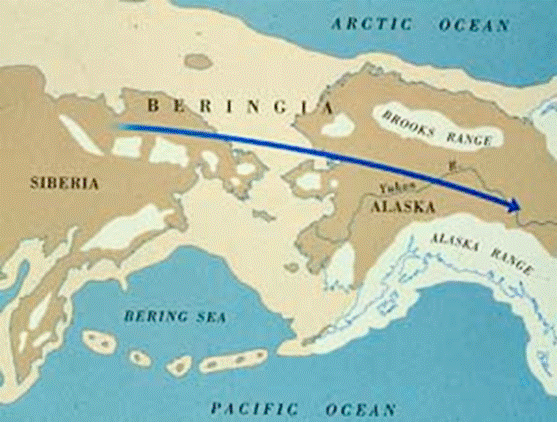A Short History of the Human Race
Part 1, The Late Pleistocene, A Story of Survival
By Ed Caryl
The story of the human race, Homo Sapiens, is really a story driven by climate, particularly temperatures, rainfall, and sea level. Most of that history has taken place in the last 20,000 years, since the Last Glacial Maximum (LGM). But there was also some pre-history. Before we could advance to civilization, we needed to survive the the last glacial period. This was not easily done. 100,000 years ago, there were several species of Homo. By 10,000 years ago there was just us, and that was just by the skin of our teeth. There is genetic evidence that in the period around 70,000 years ago, there may have been as few as 10,000 Homo Sapiens in the world.
Figure 1 is a plot of Deuterium in a Greenland ice core, GISP2, a proxy for temperature.
Several points are indicated in figure 1. Reading from oldest at the right to the present day at the left, the Toba super-volcano in Indonesia caused an abrupt severe cooling that dropped the global temperature by about four degrees in a very short time. Prior to that, the climate had already cycled by similar amounts several times, but this cooling was much more severe. At that time, our ancestors were mostly confined to tropical Africa, but the cooling was accompanied by severe drying, putting pressure on the savannas in Africa that were our preferred habitat. Fortunately for us, after about a thousand years of starving out, the temperature and rainfall swung the other way, the Sahara Desert became green for a time, and we were able to migrate out of Africa through the Middle East, filling the vacuum left by Homo Erectus and putting pressure on the Neanderthals. Before the Eemian interglacial, Homo Erectus had gone extinct in Asia, except for locally adapted populations like Homo floresiensis in Indonesia and the Denisovans in central Asia. The last non-Modern Human population to die out was the Red Deer Cave people in China. They disappeared about the time Jericho was first settled in the Jordan Valley, 11,500 years ago.
Figure 2 is a detail from figure 1 of the period from 60,000 to 75,000 years ago.
This period is a perfect example of what happens in a cold period (we die) versus what happens in a warm period (we thrive). In a span of 4000 years, mankind went from a severe population bottle-neck, to spreading across three continents.
15,000 years later, about 50,000 years ago, another warm spell triggered a further migration to what is now New Guinea and Australia. All through this period, and for much of the last glaciated phase, sea levels were much lower than today, as much as 120 meters lower, joining islands and continents with dry land. Except for the migration to Australia, this meant that ships and rafts were not necessary for these migrations. Walking sufficed.
About 40,000 years ago, another super volcano erupted, Archiflegreo on the Italian coast. This triggered another 1000-year cold spell, putting more pressure on our neighbors in Europe and Western Asia, Homo Neanderthalensis. After many cycles of warm and cold, even though they were cold-adapted, their population finally collapsed 30,000 years ago.
15,000 years ago, the last great migration, that of the ancestors of the Amerindians to the New World, took place during a period nearly as warm as at present, but before the great ice sheets had melted sufficiently for Beringia to be flooded. Beringia is the continental shelf in the Bering Sea joining Asia and North America, now under 50 to 100 meters of cold sea water.
Figure 3 is a map of Beringia 21,000 years ago. Source here.
The great migrations, out of Africa, the crossing into New Guinea/Australia, the migration into the New World, were all made possible by warm, wet, periods during an ice age. When it is cold and arid, we huddle in our caves, starve and freeze. When it is warm, we multiply, innovate, and go on the move. When possible, we move to warmer and more hospitable climes, or at least empty areas. From Beringia, we populated North America and expanded to South America in about a thousand years. Just like today, when we move to Arizona or Florida, southern France or Spain.








Love the theme appropriate ad appearing at the bottom of the post: Toyota Tundra Trucks @ Permian Toyoto
This, like 1000 yr proxies, only gives an average of the conditions faced by very early man. What is borne, albeit of limited, evidence is that man lived ‘within the edge’, at the boundry if you will, of such a time. And their conditions.
Living at the edge of a glacier, retreating, would be no different today. Would it?
Something is wrong with figure 1. Toba on #1 is @ -43.2 . Figure #2 resolves @ -39.5 .
What am I missing?
It’s a time resolution problem on the chart. On figure 1, I marked the depth of the cold. In figure 2, because I could, I marked the actual time of the eruption. I didn’t mean to confuse.
The “genetic evidence” link in the first paragraph is giving me a pdf with weird character substitutions which make it unreadable. Is anyone else getting that?
An interesting read, though, for which thanks. I have also read, and can’t resist mentioning, numerous articles and papers about genetic researches which suggest that the “Out of Africa” hypothesis is itself not the last word, usually in the form of bits of mitochondrial DNA or chromosome turning up where they just “shouldn’t oughta be”. I recall, e.g., a recent article saying that comparison of (Australian) Aboriginal genes with African genes suggests that they forked something like 400,000 years ago. If so, it sounds like H. Erectus got about a bit more than we’d credited him with.
(On which topic, if anyone knows of an unpaywalled copy of “Re-Examining the “Out of Africa” Theory and the Origin of Europeoids (Caucasians) in the Light of DNA Genealogy” (Klyosov & Rozhanski, 2012), this Europeoid would really appreciate a link.)
We’ll probably never be definitively sure exactly who migrated where and when just because there’s so little of their DNA still around to test, of course. The only real certainties are (1) that we who are around now are descended from the people (however defined) who were smart enough to get through the hard times, and (2) despite that, we still manage to do a lot of amazingly stupid stuff.
P.G. – I read NTZ daily, although this is (I think …) my first comment here. Many thanks for keeping us up to speed on the news from Germany – it’s always instructive to compare the relative levels of madness in different countries!
Thanks. I really appreciate the compliments.
PG. I too thank you from Australia for NTZ. Many times I have linked your page.
Here is 3 interesting relevant links:
“On a remote forest riverbank in northern Idaho, archaeologists have uncovered evidence of human occupation going back more than 13,500 years, adding to the signs of an increasingly ancient human presence in the Northwest, and fueling the debate about how the region’s earliest settlers got there.”
http://westerndigs.org/13500-year-old-tool-making-site-uncovered-in-idaho-forest/
The KENNEWICK MAN/THE ANCIENT ONE
On July 28, 1996, two men at Columbia Park in Kennewick, Washington, accidentally found part of a human skull .
He described them as “Caucasoid” and sent a piece of bone to a laboratory to be dated. The results indicated an age older than 9,000 years, making Kennewick Man one of the oldest and most complete skeletons found in North America. Subsequent tests of other bone samples showed the skeleton to be somewhere between 8,000 and 9,500 years old.
http://www.burkemuseum.org/kennewickman
THE MAMMOTH THAT TRAMPLED ON THE HISTORY OF MANKIND
May 25, 2014
“Just a few weeks from now, scientists from across the globe will gather in the town of Les Eyzies in the Dordogne to commemorate one of the most important – and fortuitous – events in the study of human origins.
They will congregate to mark the 150th anniversary of the discovery of the Madeleine mammoth, a small piece of ancient art that provided unequivocal proof of the deep antiquity of Homo sapiens.”
http://www.pasthorizonspr.com/index.php/archives/05/2014/the-mammoth-that-trampled-on-the-history-of-mankind
I made a note about that…
Genetics disprove the Out Of Africa theory; humans are hybrids.
http://atlanteangardens.blogspot.com.au/2014/05/out-of-africa-theory-officially-debunked.html
Europeans do not have ANY african haplogroup markers
Up to 20% Neanderthal and other genes
LOTS of intermixing between separate RACES
Out Of Africa was an attempt to do away with the concept of race –
Out Of Africa is a PC theory – JUNK.
Cro Magnon 28000 years ago had fully modern DNA
Steve C:
No problem with download of ‘genetic evidence’.
A very interesting post. Thanks Pierre.
Thanks for the news, Graeme. It prompted me to investigate, and it looks as though the fonty weirdness I got is confined to my (aging) Windows machine. On the Linux Mint machine it’s fine – an encouraging step on my journey over to open source!
@DirkH – Also, http://wakeup-world.com/2013/12/16/dna-evidence-debunks-the-out-of-africa-theory-of-human-evolution/ covers more-or-less the same ground, though (alas) without the photo from a million years BC. I still want to read the original Klyosov & Rozhanski paper, though, rather than just the “alternative” sites chatting about it.
Yeah, they might have an agenda. Thanks for the link.
I like to follow the various reports on the purity of the race, and how the debate on mixing with the Neanderthals swing from no mixing to total mixing. Last I read was that ginger hair and blue eyes come from the Neanderthals? Anybody have the latest peer reviewed view? Mixed or Pure?
Most definitely mixed; arguments rage about the extent, but at least 5% or so are by now admitted even by the orthodoxy.
That’s what I have read. The Denisovans left a slightly higher percentage in SE Asians. And there is a third, unknown, DNA trace in everyone at one or two percent.
[…] the evolution and migrations of man, placed in context of a warming climate and rising sea levels. A Short History of the Human Race Part 1, The Late Pleistocene, A Story of Survival By Ed Caryl and A Short History of the Human Race Part 2 – The Climb Out Of The Ice Age By Ed […]
[…] Part 1: History Is Clear: Humans Prospered In Climates That Were Warmer Than Today’s…Died In Cooler Ones […]